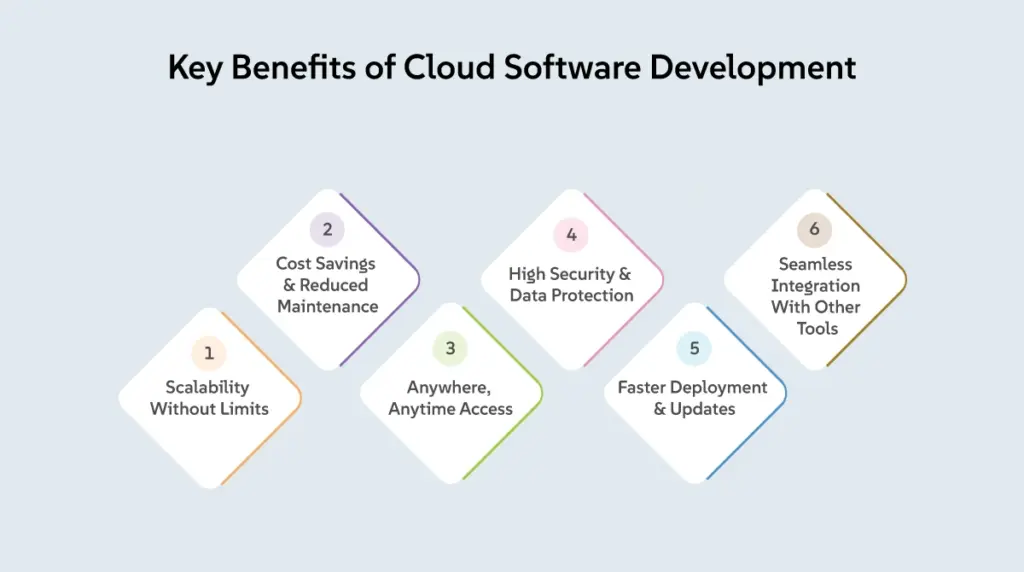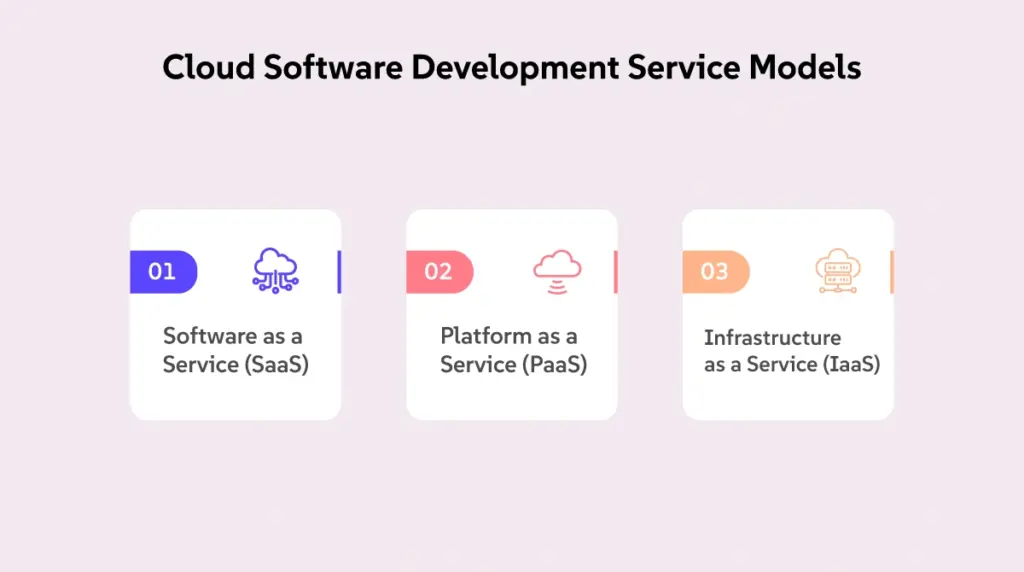The global cloud computing market is experiencing exponential growth, projected to reach $1.1 trillion in 2025, with a compound annual growth rate (CAGR) of 16% .
Imagine building software that works anywhere, anytime without the hassle of managing servers. That’s the power of cloud software development. It allows businesses to create scalable, secure, and cost-effective applications that run on the internet instead of local computers.
From startups to global enterprises, companies are shifting to the cloud for faster development, seamless updates, and better accessibility.
In this article, we will walk you through everything you need to know about cloud software development—how it works, its benefits, challenges, and the future of cloud technology.
What Is Cloud Software Development?
Cloud software development is all about building applications that run on the internet instead of your local computer.
Cloud is about how you do computing, not where you do computing.
–Paul Maritz, VMware CEO
In this case, a very relevant question is-
Have you ever used Google Drive, Dropbox, or Zoom? These are perfect examples of cloud-based software.
Instead of installing heavy programs on your device, you can access everything online. It’s fast, secure, and hassle-free.
However, Businesses love cloud software because it’s scalable, cost-effective, and easy to maintain.
Developers also benefit since they don’t have to worry about setting up servers or managing hardware. Everything runs on cloud platforms like AWS, Google Cloud, and Microsoft Azure.
But the question is: Why are companies shifting to cloud-based solutions?
In the next section, we’ll break down the key benefits and how they give businesses a competitive edge.
Key Benefits of Cloud Software Development

Switching to cloud-based software isn’t just a trend. It’s a game-changer for businesses. Companies that embrace the cloud enjoy better performance, lower costs, and unmatched flexibility.
Let’s explore the biggest advantages and how they create a competitive edge.
1. Scalability Without Limits
Cloud applications can easily scale up or down based on demand. Whether you’re a startup or a global enterprise, you don’t have to worry about server capacity or performance slowdowns.
This makes it easier to handle traffic spikes, seasonal demands, and business growth without major infrastructure costs.
2. Cost Savings & Reduced Maintenance
Forget about expensive hardware, server rooms, and IT maintenance. Cloud software eliminates the need for on-site infrastructure, cutting costs significantly.
You can now only pay for what you use. Cloud solutions are really budget-friendly and efficient.
Cloud software development significantly reduces infrastructure and maintenance costs. With no need for physical servers and minimal upkeep, teams can focus more on innovation and faster delivery.
Boomdevs Cloud Solution Expert
3. Anywhere, Anytime Access
With cloud-based applications, employees can work from any location and any device with an internet connection.
This is a huge advantage for remote teams, global businesses, and fast-moving industries. Productivity stays high, and collaboration becomes effortless.
4. High Security & Data Protection
Cloud providers invest in advanced security features like encryption, firewalls, and multi-factor authentication. Many also comply with global data protection regulations, ensuring sensitive information stays safe.
This makes cloud software more secure than traditional on-premise systems.
5. Faster Deployment & Updates
Gone are the days of manual software installations and updates. Cloud software can be deployed in minutes instead of weeks, giving businesses an edge in speed and innovation.
Automatic updates ensure that applications always run on the latest, most secure versions.
6. Seamless Integration With Other Tools
Cloud software easily connects with third-party apps like CRM systems, AI tools, and analytics platforms. This helps businesses automate workflows, improve customer experience, and boost overall efficiency.
With these benefits, it’s clear why cloud software is transforming businesses worldwide.
But how does it all work? In the following paragraphs, we’ll break down the different cloud models and which one is right for your business.
Cloud Software Development Service Models

Not all cloud solutions are the same. Businesses and developers choose different cloud models based on their needs, scalability, and budget.
Whether you’re using cloud storage, hosting a website, or running enterprise software, understanding these models is essential.
We will discuss here about 3 Models of Cloud software services development. They are:
- Software as a Service (SaaS)
- Platform as a Service (PaaS)
- Infrastructure as a Service (IaaS)
Let’s now talk about them one by one in detail. Let’s start with SaaS.
1. Software as a Service (SaaS)
SaaS applications are fully managed and hosted by a provider, requiring no installation or maintenance. Users simply log in and start working.
Examples include-
- Google Workspace
- Dropbox
- Zoom
Businesses prefer SaaS for its cost-effectiveness, automatic updates, and easy access from any device.
2. Platform as a Service (PaaS)
PaaS provides developers with a cloud environment for building, testing, and deploying applications without managing infrastructure.
It includes tools, frameworks, and databases, making development faster.
Examples include-
- Google App Engine
- AWS Elastic Beanstalk
- Microsoft Azure App Services
3. Infrastructure as a Service (IaaS)
IaaS offers on-demand computing resources like servers, storage, and networking. Businesses use IaaS to build their own platforms and applications while maintaining control over their infrastructure.
Examples include-
- Amazon EC2
- Microsoft Azure Virtual Machines
- Google Compute Engine
Choosing the right cloud model depends on business goals, technical expertise, and budget.
Now that we’ve explored cloud models, let’s move on to deployment types and how they impact software performance and security.
Cloud Deployment Types
Choosing the right cloud deployment type is crucial for performance, security, and scalability. Businesses and developers must decide how they want to store, manage, and access their applications.
Let’s discuss the four main types of cloud deployment and their impact. The 4 types are:
- Public Cloud: Cost-Effective and Scalable
- Private Cloud: Enhanced Security and Control
- Hybrid Cloud: Best of Both Worlds
- Multi-Cloud: Maximum Reliability and Performance
Now, let’s talk about all of them one by one.
1. Public Cloud: Cost-Effective and Scalable
Public cloud services are owned and operated by third-party providers like AWS, Google Cloud, and Microsoft Azure.
Businesses share cloud resources, making it a budget-friendly and highly scalable option.
It’s ideal for startups, SaaS companies, and businesses needing flexible storage and computing power.
2. Private Cloud: Enhanced Security and Control
A private cloud is dedicated to a single organization, offering better security, customization, and compliance.
It can be hosted on-premises or by a third-party provider, making it suitable for industries like finance, healthcare, and government agencies that handle sensitive data.
3. Hybrid Cloud: Best of Both Worlds
Hybrid cloud combines public and private cloud environments, giving businesses more flexibility and control.
It allows companies to store critical data in a private cloud while using the public cloud for scalability and cost-efficiency.
This is a great choice for enterprises balancing security with performance.
4. Multi-Cloud: Maximum Reliability and Performance
A multi-cloud strategy uses multiple cloud providers to reduce dependency on a single vendor.
Businesses benefit from improved uptime, better performance, and access to a variety of services.
This approach works well for large enterprises looking for redundancy and high availability.
Each deployment type serves different business needs, from cost-saving public cloud solutions to highly secure private environments.
Up next, we’ll talk about the step-by-step process of cloud software development and what it takes to build a successful cloud application.
Steps in Cloud Software Development
Building cloud software isn’t just about writing code. It’s about strategic planning, the right tools, and continuous improvements.
Whether you’re a developer, a business owner, or a tech enthusiast, understanding the process helps you create scalable, secure, and high-performing applications.
Let’s break it down step by step.
1. Define Your Goals and Requirements
Before diving in, you need to identify the purpose of your software. What problem are you solving? Who will use it? What features are essential?
These questions will help you:
- Set clear business objectives
- Choose the right cloud model (SaaS, PaaS, or IaaS)
- Consider security, compliance, and scalability needs
2. Choose the Right Cloud Platform and Tech Stack
Not all cloud platforms are the same. You’ll need to pick one that matches your project’s needs. AWS, Google Cloud, and Microsoft Azure are popular choices. Along with that, you’ll decide on:
- Backend technologies like Python, Node.js, or Java
- Frontend frameworks such as React, Angular, or Vue.js
- Databases like MongoDB, PostgreSQL, or Firebase
- Security and DevOps tools for smooth operations
3. Design Your Cloud Architecture
A solid architecture ensures your software runs fast, securely, and without downtime. This step includes:
- Choosing serverless computing or containerized solutions
- Setting up load balancers for traffic management
- Implementing microservices for flexibility and scalability
4. Develop and Test Your Application
Now comes the coding part. Using an agile approach, you build your software in small, testable sections. This makes development faster and ensures bugs are caught early. Testing includes:
- Unit testing for individual components
- Security testing to prevent cyber threats
- Performance testing to handle high-traffic loads
5. Deploy and Scale as Needed
Once your app is ready, it’s time to launch it in the cloud. But deployment isn’t just a one-time process—you’ll need to:
- Use CI/CD pipelines for smooth updates
- Monitor real-time performance and security
- Scale up or down based on user demand
6. Maintain, Monitor, and Improve
Your job doesn’t end after deployment. Cloud applications need continuous updates and improvements. You’ll:
- Track performance metrics using monitoring tools
- Fix bugs and security vulnerabilities
- Roll out new features based on user feedback
If you follow these steps, you’ll be on your way to building a powerful, cloud-based application that runs smoothly and grows with your business. But cloud development isn’t without its challenges.
Technologies & Tools for Cloud Software Development
The success of a cloud application depends heavily on the technologies and tools used to build it. From backend frameworks to security solutions, every choice impacts performance, scalability, and security.
Let’s go through the essential tools that shape modern cloud development.
1. Cloud Platforms: The Foundation of Your Software
You need a reliable cloud provider to host, manage, and scale your application. Some of the most popular options include:
- Amazon Web Services (AWS): Offers a wide range of services for computing, storage, and networking.
- Google Cloud Platform (GCP): Known for its AI and machine learning capabilities.
- Microsoft Azure: A great choice for enterprises using Microsoft products.
2. Backend Technologies: Powering Your Application
Your backend is what makes your software function. Depending on your project, you might use:
- Node.js: Lightweight and ideal for real-time applications.
- Python: Great for AI, machine learning, and web applications.
- Java: Scalable and widely used for enterprise solutions.
3. Frontend Frameworks: Building the User Interface
A smooth, user-friendly interface is crucial for a great experience. You can choose from:
- React.js: Flexible and widely used for web applications.
- Angular: Best for large-scale, feature-rich applications.
- Vue.js: Lightweight and easy to integrate.
4. Databases: Storing and Managing Your Data
Cloud applications need fast and reliable databases. Your choice depends on your data structure:
- SQL Databases (Structured Data): MySQL, PostgreSQL, Microsoft SQL Server.
- NoSQL Databases (Unstructured Data): MongoDB, Firebase, DynamoDB.
5. DevOps Tools: Automating Development & Deployment
DevOps helps you speed up development and maintain efficiency. Essential tools include:
- Docker & Kubernetes: For containerization and managing cloud applications.
- Jenkins & GitHub Actions: Automates CI/CD for smoother deployments.
- Terraform: Automates cloud infrastructure management.
6. Security Tools: Keeping Your Software Safe
Security should never be an afterthought. To protect your cloud application, use:
- Cloudflare: Shields against DDoS attacks and enhances performance.
- AWS IAM & Azure Active Directory: Manages user access securely.
- Data encryption tools: Ensures sensitive information stays safe.
Challenges in Cloud Software Development & How to Overcome Them
Cloud-based applications offer numerous benefits, but they also come with challenges. Security risks, cost management, and performance issues can create obstacles for businesses aiming for a scalable and secure cloud environment.
Let’s break down these challenges and the best ways to overcome them.
1. Security & Compliance Risks
Storing data in the cloud makes it vulnerable to cyberattacks, data breaches, and unauthorized access. Additionally, businesses must comply with regulations like GDPR, HIPAA, and SOC 2.
How to Overcome It:
- Use end-to-end encryption to protect sensitive data.
- Implement multi-factor authentication (MFA) and role-based access controls (RBAC).
- Regularly audit and comply with industry standards.
2. Performance & Latency Issues
Cloud applications depend on internet connectivity, and high latency can affect user experience. Poor infrastructure choices can lead to slow response times and system downtime.
How to Overcome It:
- Use content delivery networks (CDNs) to reduce latency.
- Optimize backend processes with serverless computing and caching.
- Choose cloud regions closer to your user base for faster performance.
3. Managing Cloud Costs
While cloud services offer flexibility, unoptimized usage can lead to high operational costs. Businesses often struggle with uncontrolled spending due to unused resources.
How to Overcome It:
- Use auto-scaling to allocate resources efficiently.
- Regularly monitor expenses with cost management tools like AWS Cost Explorer or Azure Cost Management.
- Adopt a pay-as-you-go model to avoid unnecessary charges.
4. Vendor Lock-In
Relying too much on a single cloud provider can limit flexibility and migration options. Switching to another provider becomes expensive and time-consuming.
How to Overcome It:
- Use multi-cloud or hybrid cloud strategies to reduce dependency.
- Choose open-source technologies that work across different cloud platforms.
- Design applications with portable architecture, such as containers (Docker, Kubernetes).
5. Data Migration & Integration Challenges
Moving data and applications to the cloud isn’t always seamless. Compatibility issues, data loss risks, and downtime can arise during migration.
How to Overcome It:
- Use data backup solutions before migration to prevent loss.
- Leverage cloud migration tools like AWS Migration Hub or Azure Migrate.
- Conduct thorough testing and monitoring post-migration.
6. Scalability & Resource Management
Not all cloud applications are built to handle traffic spikes and growing workloads. Poor planning can lead to performance bottlenecks and unexpected failures.
How to Overcome It:
- Implement auto-scaling mechanisms to adjust resources as needed.
- Use load balancers to distribute traffic efficiently.
- Regularly test scalability with stress testing and performance tuning.
So if you are able to tackle these challenges with the right strategies and tools, businesses can unlock the full potential of cloud computing.
Tired of Downtime, High Costs, or Apps That Just Don’t Scale?
Maybe your app keeps crashing when traffic spikes. Maybe you’re spending too much on servers and updates. Or maybe your team is stuck fixing bugs instead of building new features. It’s frustrating. It slows you down. And it costs you money.
But it doesn’t have to be this way.
At Boomdevs, we build smart, secure, and scalable cloud software solutions that work for you. So, you don’t have to worry about the tech stuff. We help you move faster, save money, and grow with confidence. No more surprise downtime. No more tech headaches.
We take care of the hard part so that you can focus on your business.
✅ Fast, reliable cloud apps
✅ Less maintenance, more freedom
✅ Custom-built for your needs
✅ Ongoing support from real people
Want to build better in the cloud?
Let’s talk. Boomdevs is here to help you do it right.
Frequently Asked Questions:
Q1: What are the most common security challenges in cloud software development?
Answer: The most common security challenges include data breaches, unauthorized access, and compliance with regulations. Implementing encryption, multi-factor authentication, and role-based access can help mitigate these risks.
Q2: How can businesses optimize cloud costs effectively?
Answer: Businesses can optimize cloud costs by using auto-scaling, regularly monitoring expenses with cloud cost management tools, and adopting a pay-as-you-go model to avoid unused resource charges.
Q3: What is vendor lock-in and how can businesses avoid it?
Answer: Vendor lock-in occurs when businesses become overly dependent on a single cloud provider. To avoid it, companies can implement multi-cloud or hybrid strategies and use open-source technologies that are portable across platforms.
Q4: How can businesses ensure smooth data migration to the cloud?
Answer: To ensure smooth migration, businesses should back up data, use cloud migration tools like AWS Migration Hub, and conduct extensive testing before and after the migration process.
Q5: What steps can be taken to improve cloud application performance?
Answer: Improving cloud application performance involves using content delivery networks (CDNs) to reduce latency, optimizing backend processes with serverless computing, and selecting cloud regions closer to the user base.
Wrapping Up:
To wrap it up, cloud software development offers great opportunities for businesses to grow and innovate. Although there are challenges, the right tools and strategies can help overcome them.
With careful planning and ongoing improvements, you can build secure, efficient cloud solutions. Are you ready to take your cloud development to the next level?



Leave a comment